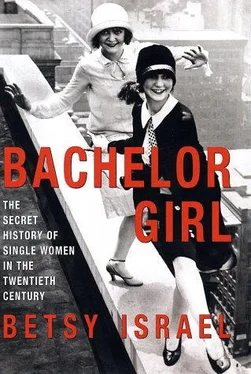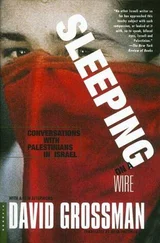As of this writing, 42 percent of the American female population over age eighteen is technically single. Most have never married, although I must note that it’s difficult to say precisely how many in this grouping are gay. (Census takers cannot by law ask, most gay-rights organizations are too financially strapped to conduct precise nationwide counts on their own, and of course many respondents would not answer truthfully. Thus, figures vary dramatically.) The never-weds are followed in number by widows and then the divorced, a number that fluctuates constantly.
Some census officials, and the professors and authors I’ll call census spectators, predict a drop in the age of first marriage (now 26.1 for men; 25.2 for women) and an “increased post-collegiate married cohort.” Others predict just the opposite, describing a country inhabited by urban “tribes,” groups of thirtyish women and men who have extended the college-era concept of the group house into adult life. (The TV phenomenon Friends picked up on this years ago.)
Whatever the prevailing trends, most every woman will one day find herself in the single subcategory, marked as I was as a single type, an inexplicably stubborn and undesirable female alien. And there will be no escaping it. As a prescient single woman wrote, in 1955, for Mademoiselle : “We are never allowed to forget what the billboards, television, movies, and the press would have us remember.”
That is the story Bachelor Girl has to tell.
CHAPTER ONE
The Classical Spinster: Redundants, The Singly Blessed, and The Early New Women
My dear, to a brighter future—when there will not be so many forced marriages, and women will be taught not to feel theirs a destiny manqué, nor the threat of poor spinsterhood, should they remain single.
—BRITISH WOMAN, NINETEEN, WRITING TO A “MOST-BELOVED” (PRESUMABLY UNHAPPY) MARRIED SCHOOL FRIEND, 1859
He: Who’s the fat lady with the heavy brows and all the hair?
She: A spinster aunt.
He: Where are you, taking the picture?
She: I’m the fat lady with the heavy brows and all the hair. I’m poor
Aunt Charlotte. And I’m still not well.
—BETTE DAVIS, HAVING LOST WEIGHT,
NOW, VOYAGER , 1942
The woman of a certain age is a very charming concept in French. In just about every other language it is a euphemism for having lost, through age, whatever charmant thing it was that made you charming. And for a woman who never married, there are no euphemisms. The “losing” in her case is a condition, a pathology. It is about as far removed from a charming concept as a brain tumor.
—DORIAN, THIRTY-EIGHT, NATIONAL PUBLIC RADIO PRODUCER, 2001
It seems safe to say that in 2002 nobody is a spinster and that a certain percentage of the population is not entirely aware of what a spinster is. For those in the latter category, I offer a brief tour of the Classical Spinster Museum.
WHAT THE OLD GIRL LOOKED LIKE:
“…grey-haired… desiccated… with a funny little tic that twitched her left eye-brow, and a mole on her upper lip….”
—A DESCRIPTION OF MISS SKIDMORE FROM
EDNA, HIS WIFE MARGARET AYERS BARNES, 1935
WHAT SHE DID EACH DAY:
“I went upstairs to my flat to eat a melancholy lunch. A dried-up scrap of cheese, a few lettuce leaves for which I could not be bothered to make any dressing, a tomato and a piece of bread and butter followed by a cup of coffee… a woman’s meal, I thought, with no suggestion of brandy afterwards.”
—MILDRED LATHBURY, HEROINE,
EXCELLENT WOMEN , BARBARA PYM, 1951
WHAT OTHERS THOUGHT (IN ADDITION TO “IT’S SO SAD”):
“A woman alone is an atrocity! An act against nature. Unmarried women pose a grave danger… our great civilization could decline… the larger health of the nation is at stake.”
—A BRITISH MP, FROM A SPEECH GIVEN IN 1922
THUS HER POTENTIAL TO BECOME A MONSTER:
“It was the third house on the right side of our street… gray ranch, white curtains, and this lady who lived there… she lived all alone and she never came out… It was the ‘cootie’s house’ because all you saw was one eyeball peeking out the corner bay window. In my child sense, she was only an eye and not a body. You had to run past.”
—EDITH, FORTY-FOUR, DANCE COMPANY ADMINISTRATOR, 2001
It’s an odd and dusty exhibition, and yet pieces of the collection are still scattered about the culture. A forty-two-year-old pianist who called herself “Mildred—definitely Mildred” says that her relatives give her money as she leaves any family event, in case, as an unmarried, childlike person, she doesn’t have her own. Another woman, thirty-eight, describes phone calls from relatives and friends who are “really calling to make sure I have not died and, as no one noticed, I’ve gone ahead and decomposed.” A single stockbroker, thirty-six, says, “My sister asks me to do errands that often require me to stand on long lines and this is ‘reasonable’ to her because she has children and I do not. What is this presumption?”
I’d call it an essential part of the spinster legacy.
IN WHICH THE SPINSTER ARRIVES
The first spinsters appeared in thirteenth-century France and a bit later in Germany and England as spinners of cotton and wool. They were not yet spinsters but femmes seules —unwed young girls, orphaned relatives, and widows of the Crusades who performed their tasks within the self-sustained family home. Most stayed there. Yet there were some who lived independently, dealing for themselves with weavers and textile merchants and often earning their praise. As late as 1783, in a Description of Manchester, we learn that “weavers were… obliged to pay more for the spinning than the price allowed by the merchants ‘but darst not complain… lest lose the spinner.’”
Long before the industrial revolution—and before the implementation of a restrictive British common law—single women worked on their own in other ways. Town and city records, portions of which have been published in academic papers, indicate that unwed women in medieval France, England, and Germany traded in raw wool, silk, and rare spices. Some engaged in foreign trading and owned their own ships, and a few are said to have managed large estates and breweries.
On into the seventeenth century, spinster was used to identify a respectable employment category. When later that century the French began using spinster to indicate an unwed woman, the term was understood to be descriptive: a woman on her own, for any number of reasons, and in need of an income.
In England, however, another spinsterly model was in the making: the Old Maid, who first took form as a loud, bosomy theater grotesque known as “the Dame.” Here was a new female creature so vain, so rabidly flirtatious she seemed unaware that the men she desired found her repulsive. For best effect, the dame was played by a man. Even in France, where the view of the serious, dedicated spinner prevailed, the playwright Molière created a protospinster, his own prehistoric Old Maid, in the form of Bélise, a conceited and oblivious character in Les Femmes savantes (1672). Bélise has never wed, and without companionship, talking to or arguing with herself or whomever happens to be standing there, she has come to believe that she’s a genius. Just as the British recognized the dame as a harridan with access to rouge pots, so French spectators recognized this blathering female as a deluded idiote .
Читать дальше












